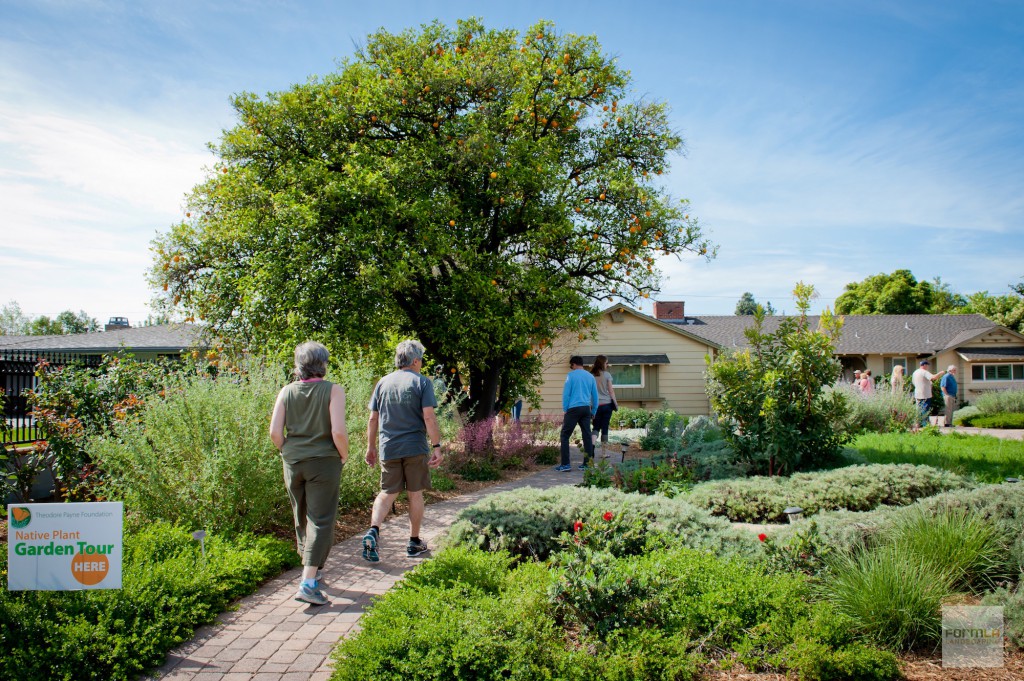Effective Design Balances Neighborhood Connection and Social Distancing
March 03, 2020 (Updated March 19, 2020). By Isara Ongwiseth: In recent years, we’ve seen a new trend, so in-keeping with LA’s indefatigable optimism, taking hold. We encountered clients and prospective clients actively seeking ways to create connection with their broader communities.
This may seem ironic now. Yet, neighborly-feeling not only enriches our life in good times – it protects us in hard times too. Likewise, the design features we harnessed to facilitate connection now support a balance between that connection and the social distancing now recommended.
By integrating features that bring homeowners into the front yard and create conversation points, gardens can make connecting with neighbors feel easy and natural. Our favorite strategies? Front garden patios, meandering trails, and edible gardens.

See the Shotgun House Coastal Garden on the (Virtual!) 2020 Native Plant Garden Tour.
Front Garden Patios
The front garden patios of Venice, South Bay, and Long Beach walk streets lead to vibrant community engagement. This feature has been rare in communities with larger lot sizes, and front yard patios certainly catch neighbors’ attention!

Many of you have visited the Kay Garden in La Canada. During the 2016 Art of the Garden Tour this award-winning space fit a crowd! People naturally wandered in small groups, due to the configuration of the space.
In times like these, the mix of gravel patios separated by banks of vibrant foliage offer an opportunity to say hi and chat from a safe distance, separated by fresh air. In simpler times, they provided the ideal semi-private space perfect for making and getting to know new friends.
Meandering Trails
The Moore Garden, featured in the LA Times, and on the 2018 Native Plant Garden Tour, contains decomposed granite and brick trails that meander under fruit bearing trees and past an abundance of native foliage and roses. The Moore’s now frequently walk the space, inspecting blooms and dodging hummingbirds. This makes chance encounters with neighbors more likely, and creates the opportunity to invite new friends to walk with them – perhaps at a good distance.

In the Schumacher garden, featured on the 2019 Art of the Garden Tour, visitors can follow a walk through the couple’s rose collection to the front door. Alternatively, they can wander decomposed granite trails past an abundance of native plants, succulents and citrus trees to arrive at a hidden patio. It is wrapped by the home on two sides, a Catalina Cherry hedge, and a low wall covered with California Lilac. Here, the Schumacher’s can privately witness neighborhood life, or invite passing neighbors to sit and chat awhile.

In both the Moore and Schumacher gardens, the presence of citrus trees and fruit-bearing natives mean there are always birds, butterflies and bees to witness and treats to offer visitors. This brings us to perhaps our most engaging front garden design strategy – and perhaps the most useful today, as it offers the ability to save neighbors and friends a trip to crowded grocery stores.
Sidewalk-Side Veggies
In the historic preservation zone of Windsor Square, the Matloff family set their hearts on creating a garden that sparked opportunities to connect with neighbors, often essentially walled off from one another by expanses of turf grass and tall hedges.

We placed a grey-water fed orchard alongside their driveway and raised veggie beds separated from the sidewalk by a bank of pollinator-attracting Cleveland Sage, Yarrow, and Indian Mallow. These features support the Matloffs’ commitment to a net zero lifestyle. Front yard edible gardens mean there is always have something beautiful and nutritious to offer neighbors – as well as the passersby who stop to use bountiful sidewalk-side blooms as a #superbloom Instagram backdrop.
Whether you are looking for a way to create community or to more safely see friends, we hope this sparks ideas! As we all work to protect ourselves and one another, we’ll be sharing more tips and stories via FormLA’s Facebook, Instagram and YouTube channels. Stay tuned and stay safe.
More Information